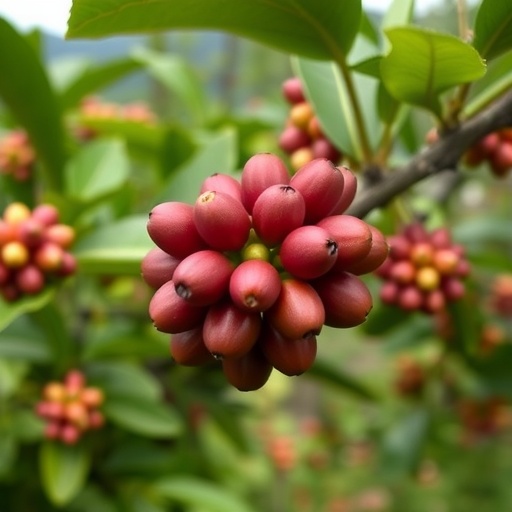A groundbreaking global analysis spearheaded by researchers from the Smithsonian’s National Zoo and Conservation Biology Institute (NZCBI) and the Smithsonian Tropical Research Institute (STRI) reveals a critical blind spot in current sustainable coffee and carbon-capture initiatives. These programs have largely prioritized incentivizing the planting of new shade trees on coffee farms as a climate mitigation strategy, yet fail to reward the protection and preservation of mature shade trees already flourishing in existing agroforestry systems. This oversight has profound implications for both carbon sequestration and biodiversity conservation in coffee-growing landscapes worldwide.
Coffee agriculture spans more than 10 million hectares globally and is highly heterogeneous in its farming systems, ranging from sun coffee monocultures that lack tree cover to more ecologically complex agroforestry systems enriched with diverse, native shade trees. These shade trees play multifunctional roles, providing essential shade that buffers coffee plants from climatic stress, serving as critical habitat for wildlife, and functioning as substantial reservoirs of carbon storage. The study, published in Communications Earth & Environment, quantifies and contrasts carbon storage capacity across this spectrum of coffee production systems, underscoring the disproportionately high carbon stocks held in mature shade-grown systems.
Through an extensive literature review encompassing 67 scientific studies from major coffee-producing regions, the researchers quantified aboveground carbon storage in diverse coffee farm types and extrapolated these values to global coffee land-use patterns. Their findings reveal that coffee farms currently store approximately 482 million metric tons of carbon above ground. Despite the common practice of promoting tree planting as a carbon offset mechanism, the modeled scenarios suggest that even if every sun-grown coffee farm worldwide planted new shade trees, the maximum achievable carbon sequestration gain would be between 82 to 87 million metric tons. In stark contrast, converting all shade-grown coffee farms to sun monocultures could release between 174 and 221 million metric tons of carbon into the atmosphere.
This imbalance exposes a critical flaw in existing carbon market frameworks that predominantly reward the establishment of new trees without offering financial compensation for the retention of mature trees. The incentive structure inadvertently encourages coffee producers to clear older, carbon-dense shade trees in favor of planting younger, faster-growing species that generate carbon credits but store considerably less carbon overall. Such perverse incentives threaten to undermine recent investments aimed at mitigating climate change through agroforestry and risk accelerating habitat degradation.
Beyond carbon dynamics, the research highlights the nuanced relationship between tree density, carbon sequestration, and biodiversity support. While carbon storage tends to correlate positively with increasing tree density, biodiversity benefits from tree species diversity rather than mere abundance. Shade-coffee farms characterized by a heterogeneous canopy of native trees harbor roughly four times more bird species than their monoculture counterparts. This biodiversity facet lies at the core of the Smithsonian Bird Friendly certification, which sets rigorous standards for shade tree density and diversity and facilitates market access for certified coffee producers commanding premium prices.
The study elucidates emerging tensions within coffee farming communities, who face growing economic pressures and productivity challenges exacerbated by climate change. Some farmers, under pressure to maximize yields, resort to removing shade trees, despite evidence that these trees contribute to microclimatic regulation by mitigating temperature extremes and stabilizing moisture. Simultaneously, leading coffee companies are investing millions in tree-planting programs linked to carbon credits, but these corporate efforts risk falling short of climate targets if they overlook the critical importance of conserving existing mature shade trees.
Senior author Ruth Bennett, an ecologist at NZCBI and coordinator of the Smithsonian Bird Friendly program, emphasizes that while planting shade trees on degraded coffee farms is beneficial, it cannot fully compensate for the substantial carbon and biodiversity losses incurred when mature trees are cut down. The researchers call for policy reforms that integrate carbon payments explicitly rewarding the protection of existing shade trees and ensure accessibility of these incentives to smallholder growers who dominate global coffee production.
Moreover, the findings advocate for a paradigm shift in tree-planting initiatives to prioritize planting a diverse suite of shade tree species tailored to local ecological and agronomic contexts. Postdoctoral fellow and lead author Emily Pappo stresses that a focus solely on carbon sequestration metrics risks sidelining biodiversity objectives—the two goals should be pursued concurrently to realize holistic landscape benefits. The research also signals the need for improved tools and resources to guide farmers in selecting shade trees that optimize carbon storage, foster biodiversity, and maintain or enhance coffee yields.
Building on this foundation, the Smithsonian team is developing the Shade Catalog, an innovative resource designed to help coffee farmers identify shade tree species that align with their productivity goals while supporting wildlife habitat and ecosystem services. Concurrently, Bird Friendly-affiliated scientists are advancing decision-support tools that assist farmers in balancing competing demands of carbon storage, biodiversity conservation, and farm profitability, ensuring that future coffee landscapes contribute effectively to climate mitigation and ecological resilience.
This comprehensive study imparts a cautionary message to the coffee industry and environmental policymakers alike: without recalibrating carbon payment frameworks to reward the retention of mature shade trees and prioritizing tree diversity in planting efforts, coffee agroecosystems may continue to lose stored carbon and biodiversity despite ongoing tree-planting investments. The researchers recommend urgent integration of biodiversity-informed carbon strategies to safeguard the dual ecological and climatic functions coffee farms can provide. Their findings have critical implications for the design of sustainable agriculture models that reconcile climate mitigation with ecosystem health in one of the world’s most economically and ecologically significant crops.
Subject of Research: Not applicable
Article Title: Carbon payment strategies in coffee agroforests shape climate and biodiversity outcomes
News Publication Date: 19-Aug-2025
Web References:
- Smithsonian’s National Zoo and Conservation Biology Institute: https://nationalzoo.si.edu/
- Smithsonian Tropical Research Institute: https://stri.si.edu/
- Journal Article DOI: https://doi.org/10.1038/s43247-025-02574-w
References:
Communications Earth & Environment, DOI: 10.1038/s43247-025-02574-w
Image Credits: Roshan Patel, Smithsonian’s National Zoo and Conservation Biology Institute.
Keywords: Agroecosystems, Agriculture, Climate change mitigation, Ecosystem services, Sustainability, Sustainable agriculture




